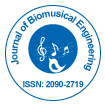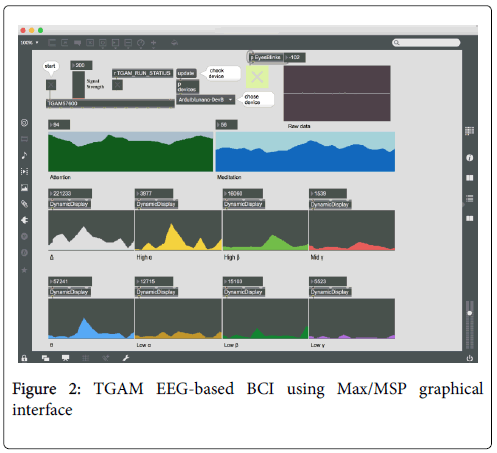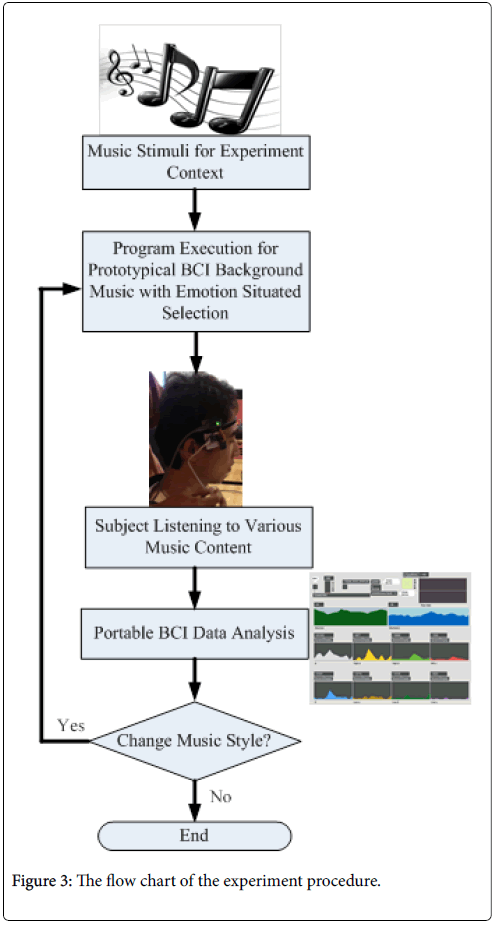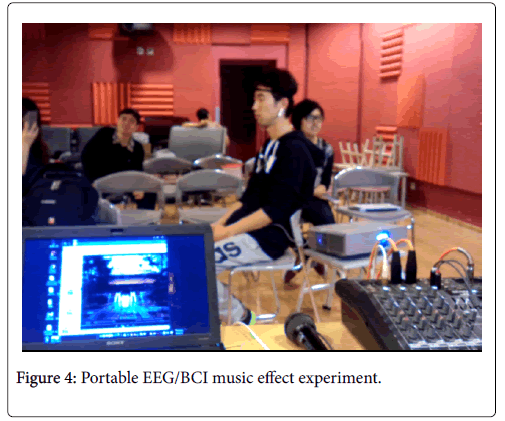Mini Review Open Access
A Pilot Study on the Portable EEG-Based Music Effects
Lin S2*, Chih-Fang H1,2 and Bo-Yuan L2
1Department of Information Communications, Kainan University, Taiwan
2Shanghai Normal University Music College, China
- Corresponding Author:
- Lin S
Music Technology Department
Shanghai Normal University, China
Tel: 86-10-66093900
E-mail: shenlin@shnu.edu.cn
Received date: December 24, 2015 Accepted date: January 7, 2016 Published date: January 11, 2016
Citation:Lin S, Chih-Fang H, Bo-Yuan L (2016) A Pilot Study on the Portable EEG-Based Music Effects. J Biomusic Eng S1:002. doi:10.4172/2090- 2719.S1-002
Copyright: © 2016 Lin S, et al. This is an open-access article distributed under the terms of the Creative Commons Attribution License, which permits unrestricted use, distribution, and reproduction in any medium, provided the original author and source are credited.
Visit for more related articles at Journal of Biomusical Engineering
Abstract
Previously electroencephalogram (EEG) based BCI (Brain Control Interface) is very complicated for the homebased users. This paper presents a pilot study on the portable EEG-based BCI system to find the music effect relation between music genres and human’s attention and meditation. Music genres for various background music styles are analyzed for the experiment, to obtain the subjects’ EEG data with various attention and meditation levels. Finally we found that the classical symphonic music makes subjects obtain the most significant response, and the proposed method can be adopted for the fields of music healing, education, and entertainment, hopefully.
Keywords
Portable EEG-based BCI; Attention; Meditation; Music genres; Background music
Introduction
The non-invasive EEG/BCI system is a huge system originally, which makes users much inconvenient in the traditional usages and requires complicated software and hardware implementations [1,2]. Nowadays the EEG/BCI products have been developed into the portable wearing technology based market in recent years. Some of the portable EEG-based BCI products have been even applied into the entertainment fields [3,4]. Several applications of BCI is used to control the medical facilities, such as the wheelchair [5]. Music healing is also becoming one of the EEG/BCI applications, such as the tension and stress release [6,7]. Currently some simplified portable EEG-based BCI have been developed for people to use easily, such as the TGAM (ThinkGear AM) chip [8] with many applications, including nerorobotics [9], and learning [10,11]. There are some usages of the portable TGAM-based EEG/BCI for music, such as music player [12] and sound for virtual reality therapy with both attention and meditation level measurement [13]. In this paper, we would like to present a convenient home-based EEG/BCI system using TGAM to find the music categories related to human’s attention and meditation.
Method
This research provides a convenient way to find the relation between human’s attention/meditation levels and music categories. The follows shows more detailed methodology of this research.
Music classification
According to Gjerdingen RO and Perrott D’s research [14], 10 main genres of popular music are widely recognized in the late 1990s, including (1) Blues, (2) Classical, (3) Country, (4) Dance, (5) Jazz, (6) Latin, (7) Pop, (8) R & B, (9) Rap, and (10) Rock. We choose Rock and Roll, and Pops Folk Song from the popular music genes as our music stimuli. In the meantime, Traditional Chinese Confucius Temple Music is also selected as one of the music genes for this research, while Classical Symphonic Music is selected as the Classical genres. Figure 1 shows the music classification for the portable BCI/EEG experiment of this research. Table 1 shows the music genres with the correspondent pieces used for the experiment.
| Music Genres | Pieces Used for the Experiment |
|---|---|
| Rock and Roll | The Beatles |
| Pops Folk Song | Pops Chinese Folk Song |
| Traditional Chinese Confucius Temple Music | Taipei Confucius Temple Music |
| Classical Symphonic Music | Mozart’s Symphony |
Table 1: Music genres with the correspondent pieces used for the experiment
Elements of music
There are 8 elements of music including (1) Rhythm, (2) Melody, (3) Harmony, (4) Form in music, (5) Forms of music, (6) Tempo, (7) Dynamics, and (8) Tone color [15]. In this paper, we select four of the most significant music features to compare with the subjects’ response, including (1) Rhythm, (2) Harmony, (3) Tempo, and (4) Dynamics, as shown in Table 2.
| Elements of Music | Range |
|---|---|
| Rhythm | Simple <--> Complex |
| Harmony | Consonant <--> Dissonant |
| Tempo | Slow <--> Fast |
| Dynamics | Quiet <--> Loud |
Table 2: Four most significant music features used for the experiment.
Graphical interface for the EEG-based BCI
The proposed method to display the EEG-based BCI data is to use Max/MSP program [16] as the TGAM data acquisition system. The EEG raw data includes delta (0.5-2.75Hz), theta (3.5-6.75Hz), lowalpha (7.5-9.25Hz), high-alpha (10-11.75Hz), low-beta (13-16.75Hz), high-beta (18-29.75Hz), low-gamma (31-39.75Hz), and mid-gamma (41-49.75H) [17], as shown in Figure 2. However the most two signal levels are “attention” and “meditation”, indicating human’s attention and meditation activities.
Experiment
There are six subject listening to music in various styles, as the above mentioned. Three of them are musicians with more than 10 years professional instrumental training; and the remaining three nonmusician subjects are amateur music lovers. The experiment procedure and experiment facility is depicted as the following sections.
Experiment procedure
The experiment procedure can be described into the following steps:
Find proper Music Stimuli for the proposed experiment context;
Perform program execution for the prototypical BCI background music with various emotion situated selections;
Make the subjects listening to various music content and styles;
Perform portable BCI data analysis;
Confirm to see if any change is needed for various music style;
If it needs to change the music style, then go back to item (2); if not, then go to the end.
The flow chart of the experiment procedure is as shown in Figure 3.
Experiment facility
The following equipments are used for our proposed EEG/BCI music effect analysis:
Mixer: A 4-channel analog mixer for sound system
Speakers: A set of stereo speakers with amplifier
PC: Max/MSP program with PC to perform EEG/BCI data acquisition with GUI
Portable EEG/BCI: TGAM Chip with Blue Tooth 2.0 wireless communication for PC
Figure 4 shows the portable EEG/BCI music effect experiment.
Result
According to the experimental result, the classical symphonic music makes subjects obtain the most significant response, including both attention and meditation levels. However after it repeats several minutes, attention level decreases, and meditation level gradually maintains into the middle level. As we know, classical music shows its contrast in harmony, rhythm, tempo, and dynamics much more significant than other music genres. The second strength of music content attention/meditation associativity is derived from the traditional Chinese confucius temple music. It may happen significantly for Chinese people. We may need non-Chinese subjects to join the experiment for this issue in the future research.
No matter which category of music, in the first minute, the subjects’ EEG data vary greater than the values after one minute. After one minute later, the subject may gradually get into the “music world”, therefore EEG data varies slower and smaller, but the correspondent music features, especially the music chord changes make EEG vary up and down with greater values.
Basically the music effect strength in the degree of EEG associated with both Attention and Meditation levels is as follows (from the greatest to the smallest in sequence):
Classical Symphonic Music
Pops Folk Song
Traditional Chinese Confucius Temple Music
Rock and Roll
Musician subjects show higher degree of association between the EEG attention/meditation levels and the music content than the nonmusician subjects, such as the chord, rhythm, and tempo changes.
Conclusion
This proposed method and experiment to find the relation between music genres and human’s attention/meditation can be basically found from the portable EEG-based BCI device. This pilot study can be used in the fields of music recommendation system, music healing, music therapy, music education, and some other fields related to medical and music interdisciplinarily. The independent levels of attention and meditation related to music features should be investigated in the future research with further analysis. The future trends of cloud computing with big data analysis with the EEG-based bio-feedback can be also adopted in the future, to fulfill the intelligent home-based system with the integration of music therapy, entertainment, and education.
References
- Broetz D, Braun C, Weber C, Soekadar SR, Caria A, et al. (2010) Combination of brain–computer interface training and goal-directed physical therapy in chronic stroke: a case report. Neurorehabilitation and Neural Repair.
- Guger C, Ramoser H, Pfurtscheller G (2000) Real-time EEG analysis with subject-specific spatial patterns for a brain-computer interface (BCI). Rehabilitation Engineering, IEEE Transactions on 8: 447-456.
- Lalor EC, Kelly SP, Finucane C, Burke R, Smith R, et al. (2005) Steady-state VEP-based brain-computer interface control in an immersive 3D gaming environment. EURASIP journal on applied signal processing 3156-3164.
- Bos DPO, Reuderink B, van de Laar B, Gürkök H, Mühl C, et al. (2010) Brain-computer interfacing and games. In Brain-Computer Interfaces, Springer London.
- Huang D, Qian K, Fei DY, Jia W, Chen X, et al. (2012) Electroencephalography (EEG)-based brain–computer interface (BCI): A 2-D virtual wheelchair control based on event-related desynchronization/synchronization and state control. Neural Systems and Rehabilitation Engineering, IEEE Transactions on 20: 379-388.
- Sulaiman N, Taib MN, Lias S, Murat ZH, Aris SA, et al. (2011) Novel methods for stress features identification using EEG signals. International Journal of Simulation: Systems, Science and Technology 12: 27-33.
- Tran Y, Thuraisingham RA, Wijesuriya N, Nguyen HT, Craig A (2007) Detecting neural changes during stress and fatigue effectively: a comparison of spectral analysis and sample entropy. In Neural Engineering 350-353.
- Yanke C, Shui W (2015) The key techniques research on portable EEG examination expert system. In Computer Science & Education (ICCSE) 975-978.
- Méndez-Gordillo AR, Villagómez-Galindo M, Espinosa-Medina MA Design and Construction of a Brain-Computer Interface for Applications in Neuro–Robotics.
- Geeta N, Gavas RD (2014) Enhanced Learning with Abacus and its Analysis Using BCI Technology. International Journal of Modern Education and Computer Science (IJMECS) 6: 22.
- Israsena P, Hemrungrojn S, Sukwattanasinit N, Maes M (2015) Development and Evaluation of an Interactive Electro-Encephalogram-Based Neurofeedback System for Training Attention and Attention Defects in Children. Journal of Medical Imaging and Health Informatics 5: 1045-1052.
- Liu NH, Hsu HM, Chu HC, Hsu SH (2013) Intelligent Music Player for Bike Sport Using Electroencephalogram and Global Positioning System Sensors. Sensor Letters 11: 772-780.
- Perhakaran G, Yusof AM, Rusli ME, Yusoff MZM, Mahalil I, et al. (2016) A Study of Meditation Effectiveness for Virtual Reality Based Stress Therapy Using EEG Measurement and Questionnaire Approaches. In Innovation in Medicine and Healthcare, Springer International Publishing, London.
- Gjerdingen RO, Perrott D (2008) Scanning the dial: The rapid recognition of music genres. Journal of New Music Research 37: 93-100.
- Gary CL (1967) The Study of Music in the Elementary School: A Conceptual Approach, Music Educators National Conference, USA.
- Tokunaga T, Lyons MJ (2013) Enactive Mandala: Audio-visualizing Brain Waves. In The International Conference on New Interfaces for Musical Expression (NIME).
- ThinkGear Serial Stream Guide (2015).
Relevant Topics
Recommended Journals
Article Tools
Article Usage
- Total views: 13884
- [From(publication date):
specialissue-2016 - Aug 28, 2025] - Breakdown by view type
- HTML page views : 12609
- PDF downloads : 1275




